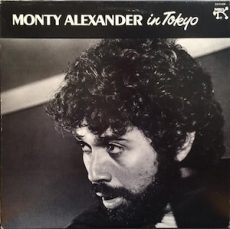
Requisites
Monty Alexander In Tokyo | By Eddie Carter
I first heard Monty Alexander In Tokyo (Pablo Records 2310-836) in 1985 at the former jazz station, WNOP 740 AM, after my move to Cincinnati from Cleveland, Ohio. It was recorded during the pianist’s first trip to the city and is his nineteenth release as a leader. Here, he is working with two of the best in the business: Andy Simpkins on bass and Frank Gant on drums. My copy is the 1979 U.S. Stereo pressing, and the trio opens this musical adventure with a trip to Broadway by Billy Byrd, Teddy McRae and Henri Woode. They begin this catchy tune with a delightfully crafted melody. Monty cuts loose in a spirited statement that’s sure to have your fingers popping and toes tapping along until the song’s conclusion.
Just In Time by Jule Styne, Betty Comden, and Adolph Green starts with a short introduction by Monty, segueing into the threesome’s pulsating theme, who treats the standard like an old friend. Monty comes alive in the song’s only interpretation ahead of the closing chorus and finish. Sweet Lady is a lovely ballad by Dave Zoob, Frank Crumit, and Howard E. Johnson. It’s a showcase for Monty and Andy, who start the song with a tender introduction that leads to their enchanting melody. The duo sustains the gentle mood in the delicately sensitive statement they share, preceding a polite reprise and climax.
Tricotism by Oscar Pettiford begins with the trio introducing this happy swinger collectively before taking the theme at a fast clip. Monty kicks off the solos with a scintillating opening statement; then Andy takes over for a bit of brisk walking. The pianist has a second interlude before Frank engages in a short workout ahead of the melody’s restatement and ending. Never Let Me Go by Jay Livingston, and Ray opens with the threesome’s slow-tempo introduction. The pace picks up to a medium beat for the opening chorus, ahead of the pianist’s driving solo that has something to say into the closing chorus.
Up next is Montevideo by Richard Evans, which takes off from the opening notes of the trio’s upbeat introduction and melody. The rhythm section spurs Monty to soar into the stratosphere in the song’s only statement until he returns to Earth for the theme’s reprise and abrupt ending. Pawnbroker by Quincy Jones is a very pretty ballad from the 1964 film drama. It’s a solo showcase for Monty Alexander, and the pianist uses the poignant melody effectively to depict the song’s sincerity and melodic beauty in a gorgeous interpretation, preceding the melody restatement and a lovely summation.
See See Rider by Ma Rainey brings the album to a close on an upbeat note. The trio starts expressing their joy and pleasure in the melody. Monty is up first with an especially impressive interpretation; then Andy takes a short walk through the second reading. The pianist puts the finishing touches on the song ahead of the closing chorus and ending. Monty Alexander produced Monty Alexander In Tokyo, and Katsuyuki Handa and Kazutoyo Takeda were the recording engineers. The sound quality is excellent, with a vivid soundstage that transports the trio to your listening room’s sweet spot.
Whether you’re new to Monty Alexander’s music or a seasoned fan, Monty Alexander In Tokyo is a versatile album that’s perfect for any occasion. It’s the perfect soundtrack for a relaxing evening or a lively dinner with friends. I highly recommend adding it to your jazz library. With its diverse range of tracks, it’s a testament to the trio’s musical prowess and a must-have for anyone who loves a piano trio!
~ Just In Time – Source: JazzStandards.com
~ Broadway, See See Rider – Source: Wikipedia.org
© 2024 by Edward Thomas Carter
More Posts: choice,classic,collectible,collector,history,instrumental,jazz,music,piano


